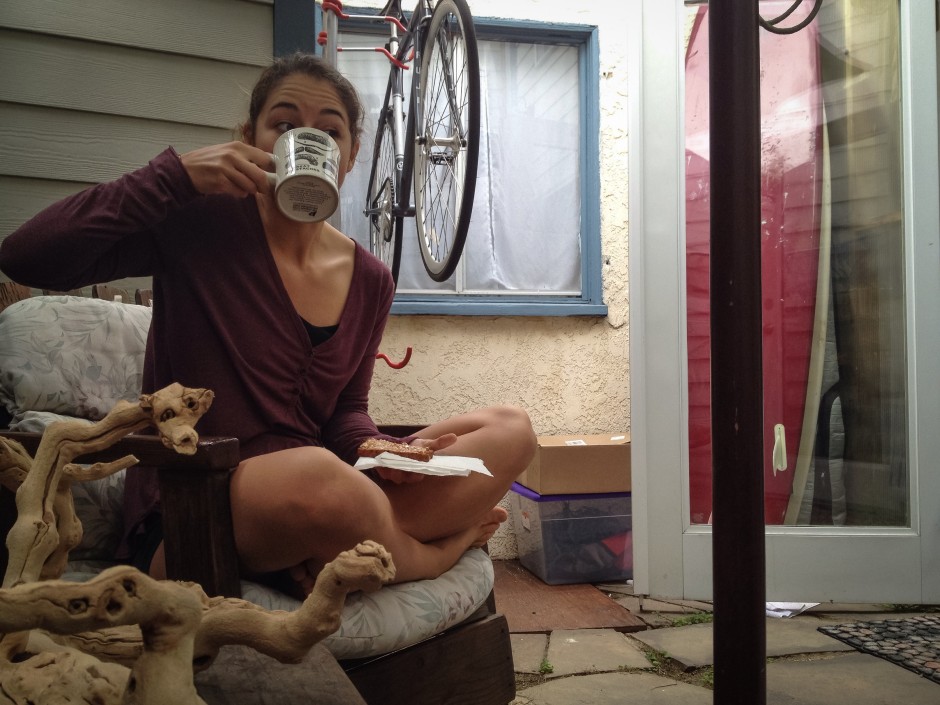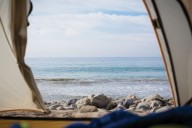In preparation for our travels, we made several adjustments to our lifestyle in order to compound our savings in a relatively short period of time. Although we sacrificed a lot, we tried our hardest to make sustainable decisions that allowed us to maintain certain aspects of our lives- at times even changing things for the better. Below are some steps we took to strengthen our finances, reduce our possessions, and prepare for 420 days on the road.
1. Downsized our home, reduced rent
We went from paying $2,050/month (collectively) for a 2,000 sq. ft. apartment that we shared with one of our good friends ($3,300 total rent) to finding an affordable 400 sq. ft. apartment on Airbnb. This reduced our rent down to $1,250/month (collectively) – with cable, internet, and all utilities covered. The home was also only 3 miles from work and 1 mile from the beach. This was a huge win for us, a giant leap toward financial security.
2. Sold everything we didn’t need
If we couldn’t take it with us and if it wouldn’t be of value in two years- we sold it. Extra cameras, old phones, miscellaneous gadgets, vehicles, furniture, area rugs, artwork – all gone. This was not only an incredibly liberating feeling, but it also lightened our load and made us some extra cash for our trip.
3. Reduced Gas Bill by “Training”
About six months before our trip we began “training” by riding our bicycles to work. This saved us an average of $80/month on gas while helping us prepare for the physical nature of our global trek.
4. Reduced Utility Costs by putting on a sweater
We lived in California, so cold weather wasn’t a big issue, but during winter months we saved on utility bills by simply putting on warmer clothes or hiding under a blanket. Epic cuddle sessions, to say the least.
5. Began doing groceries and eating at home
Talk about savings. For the two of us, we spent (on average) $80 on groceries every two weeks. Whether shopping at Trader Joe’s or Whole Foods, this amount always sufficed.
6. Got by on 1 vehicle and carpooled
We had three vehicles, collectively. About 9 months before our trip, we sold off two of them and got by on 1 vehicle for the remainder of our L.A. residency. It helped that we worked for the same company, so we were able to carpool to work every day. All in all, this saved us approximately $500/month.
7. Found free fun
Free and/or inexpensive fun is, surprisingly, easy to find (even in an expensive city like Los Angeles). Surfing, hiking, camping, urban exploring, museums, there are tons of things to do. For us, we each allotted ourselves a $200/month entertainment budget. Whether eating out, going to the movies, or grabbing a cup of coffee, we never exceeded this monthly allocation.
8. Packed lunch for work
As part of our bi-weekly grocery budget, we always made sure to grab enough food for lunch. As we could’ve easily spent $10/day each for lunch, this was a huge cost-saving opportunity.
9. Spent less money on alcohol
Here’s an easy one. No explanation required.
10. Made our coffee at home
An espresso machine and a little bit of Almond Milk and you’re golden. Bye bye $4.95 Iced Latte.
11. Obtained reward credit cards
Flyer mile bonuses, double miles on certain purchases, complimentary travel insurance, free checked bags… the benefits are plentiful. Signing up for 1 or 2 travel credit cards will be one of the best decisions you make in planning for your trip. As an example, each of us generated over 100,000 flyer miles before our trip. Our one-way flight to London cost us 35,000 miles and $5. At the moment, neither of us are planning to pay for a single flight on our round-the-world trip.
12. Worked freelance jobs, side hustled
To supplement the income from our day jobs, both of us managed to hold down freelance gigs on our nights and weekends. Kevin made extra money with event photography and Emily brought in some extra cash teaching surf lessons at a local surf shop. Collectively, we managed to generate around $400-$500 in extra income each month.
13. Taxes & bonuses
Don’t forget tax and bonus season. If you’ve been good, you should see a few extra funds hitting your bank account in early February.
14. Skipped the holidays
Give your significant other the gift of world travel. Save on meaningless trinkets and put those extra funds toward your trip.
15. Took advantage of sales
Seasonal sales are a great opportunity to score brand-new or like-new gear for your trip at heavy discounts. Black Friday, as an example, can be the craziest shopping day of the year, but if you shop online you can save at all your favorite stores without the hassle.
16. Became an REI Member
As an REI member, you’re susceptible to a slew of great advantages. For one, you’re invited to their quarterly “Garage Sales” where they sell lightly used & returned gear at extraordinary discounts. Secondly, you can return any goods purchased at REI (at any time) for a refund or store credit. Last but not least, at the end of each year, you’ll receive a 10% dividend on all the money you spent in their store. Score.
17. Took advantage of employee discounts & benefits
Depending on your current employer, you might be eligible for pro-deals on sites like Promotive. Luckily, working in the action sports industry, we both had access to a pro-deal site where we saved anywhere from 30-60% on various items for our trip.
Additional things you can do to save:
1. Get rid of cable
It’s an expensive and archaic service. As an alternative, try Netflix or Hulu. For $10-$16/month you can obtain all the at-home entertainment you’ll ever need. If you absolutely have to watch a big sporting event, head to your local bar or hop over to a buddy’s house.
2. Give up that gym membership
All the exercise you need can be found outside. Naturrrrrre.
3. Rent out your room
If you have extra space in your home, try renting it out on Airbnb. People are making loads of extra cash on this website while meeting interesting people from all around the world.








